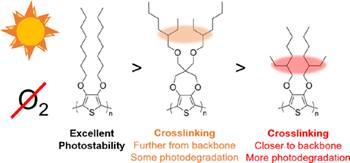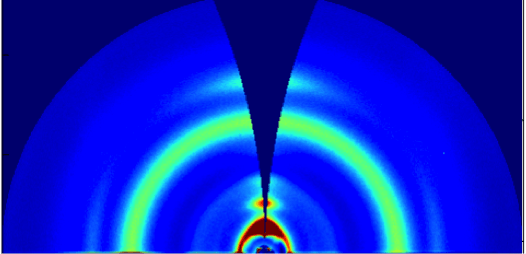Solubility and aggregation properties of the active layer solution directly affect optimal processing conditions for fabrication organic solar cells. The Reynolds group has shown small alteration in the monomer composition for synthesis of an aggregating donor-acceptor copolymer, PffBT4T-2OD (PCE11), controls the polymer aggregation by introducing backbone disorder which then results in optimized processability. Characterizing the drying process using real-time characterization methods, Reynolds group discovered how the acceptors (fullerene- and non-fullerene-based) affect the kinetics and extent of polymer crystallization during processing. Polymer structure is tuned to access ambient blade coating of thick layers to best model scalable processing. Usage of cosolvents showed 3-fold improvement in the device performance. It is believed cosolvents decreases the domain size relative to the single solvent system and move the drying mechanism away from what is likely liquid–liquid phase separation to solid−liquid phase separation driven by polymer aggregation.
Photostability of thin films under oxygen-free conditions of a family of dialkoxy-functionalized thiophene polymers is studied to understand photodegradation pathways and the structure–property relationships. Using a combination of UV–vis–NIR spectroscopy, X-ray photoelectron spectroscopy, size exclusion chromatography, nuclear magnetic resonance, and cyclic voltammetry, we evaluate if and how defects such as crosslinking, chain scission, and/or chemical changes affecting the conjugated backbone impact the rate of photodegradation.

We demonstrate that crosslinking through the alkyl side chains is the main degradation pathway under oxygen-free conditions, and that backbone twisting plays an important role in the rate of photodegradation.
1. Pelse, I.; Jones, A.L.; Richter, L.J.; Reynolds, J.R. Probing Crystallization Effects when Processing Bulk-Heterojunction Active Layers: Comparing Fullerene and Nonfullerene Acceptors. Chem. Mater., 2021, 33, 2, 657-667.
2. Xu, B.; Pelse, I.; Agarkar, S.; Ito, S.; Zhang, J.; Yi, X.; Chujo, Y.; Marder, S.; So, F.; Reynolds, J.R. Randomly Distributed Conjugated Polymer Repeat Units for High-Efficiency Photovoltaic Materials with Enhanced Solubility and Processability. ACS Appl. Mater. Interfaces, 2018, 10, 51, 44583-44588.
3. Pelse, I.; Hernandez, J.L.; Engmann, S.; Herzing, A.A.; Richter, L.J.; Reynolds, J.R. Cosolvent Effects When Blade-Coating a Low-Solubility Conjugated Polymer for Bulk Heterojunction Organic Photovoltaics. ACS Appl. Mater. Interfaces, 2020, 12, 24, 27416-27424.
4. Shen, E.; Lang, A.W.; Collier, G.S.; Österholm, A.M.; Smith, E.M.; Tomlinson, A.L.; Reynolds, J.R. Enhancement of Photostability through Side Chain Tuning in Dioxythiophene-Based Conjugated Polymers. Chem. Mater., 2022, 34, 3, 1041-1051.

